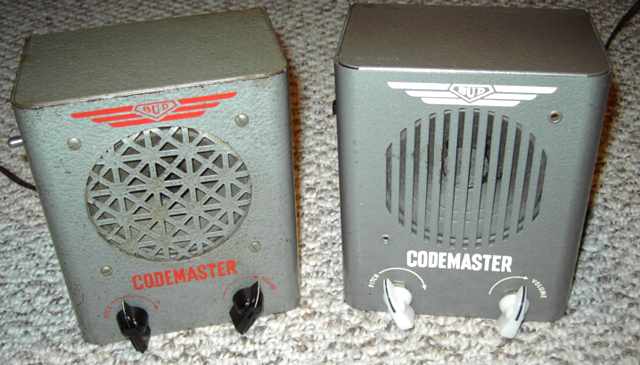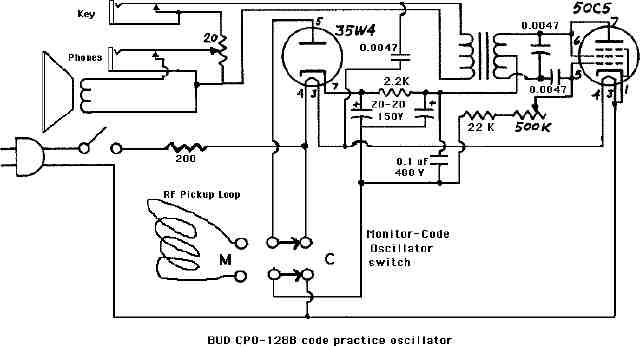
A tale of two Bud Codemasters (CPO-128A and CPO-128B)
Bud produced several code practice oscillators, with and without speakers, and in both horizontal and vertical models. The BUD CPO-128A on the left with cross hatched speaker grille and red lettering was advertised in QST magazine in August 1953 at a cost of $14.45. The BUD CPO-128B with white lettering and vertical louver speaker grille was a later improved model. Both have a built-in speaker and can be switched to transmitter monitor mode using an external RF pick-up coil. The tubes in both are a 35W4 rectifier and a 50C5 as audio oscillator/ output. The sets are AC-DC.

A major difference in circuitry, shock hazard
The older CPO-128A circuit (on the left) has a shock hazard on its key jack. The key connection switches the B+ voltage on the center tap of the output transformer primary. B+ is present on the key jack exterior and the phone plug barrel of the key connection, and therefore also on the key. Note that this is rather hazardous if you are anywhere near a grounded object (such as any appliance with a 3-wire cord). My meter read 140 Volts DC from that key jack to the case of a 3 wire grounded device. The voltage was present in both orientations of the CPO-128A power plug.The improved CPO-128B keys the secondary of the output transformer and essentially removes the shock hazard. The schematic for the 128B is below. The 128A can easily be modified to match the 128B. The 128A can also be used with just the phone jack using an external speaker and wiring the key in series with that external speaker. I recommend rewiring the hot B+ key jack or taping over the key jack and labeling it to warn of the hazard.
Another shock hazard
Note that BOTH of these Bud Codemasters use a DPDT switch to select between use as a monitor or code oscillator. That switch has exposed connections just inside the cabinet. The exposed connections carry both sides of the power line. If you decide to plug in either of these Bud Codemasters, at the very least insulate the switch connections, such as by wrapping the switch with electrical tape. I used heat shrink tubing on the 128A toggle switch connections and tape on the 128B slide switch.
 |
REPAIR NOTES These are very simple circuits. The 128A had an open power switch due to oxidized contacts. An application of Deoxit in the switch restored its function. I also used deoxit on the tone and volume control potentiometers to eliminate scratchy noise from the controls. For the long-dormant 128B, I cleaned the tone and volume controls before testing it. I also reseated the 200 ohm filament dropping resistor which had one end practically touching the metal case. After a slow power up to reform the electrolytic, it performed flawlessly.
History of these Bud Codemaster pieces
I purchased the 128A at an auction some years ago.
The CPO-128B was given to me by Duane T. who is to be congratulated on a half century of code knowledge. According to Duane:
I learned Morse Code with this Bud Codemaster. I was always very involved with radio and electronics, still am as a hobby, since the early 50's. I learned Morse Code just because of interest, and also we used it in our Boy Scout Troop for practicing for the "Radio Merit Badge". I got interested in radio as a small child when I used to turn the AM band all the way down below 550KC on an old RCA radio and could sometimes hear the Wilmington Marine Operator, as I grew up along the Delaware River. We also had an old Majestic Grigsby-Grunow Co. Model 180 radio I used to use. It was neat and got me started in electronics and my whole career. And I was very fortunate my parents encouraged me.
Thanks for giving the CPO-128B a good home, Duane.
More info on AC-DC vacuum tube code practice oscillators
The Ameco CPS code oscillators have a similar safety problem and solution.
The early Ameco CPS (1957 vintage) has the same shock hazard as the Bud CPO-128A
The later Ameco CPS code practice oscillator corrects the hazard using a similar circuit to the Bud CPO-128B with a small refinement that keeps the 20 ohm volume control across the output transformer secondary at all times. I consider it the best circuit design for the simple tube AC-DC code oscillators. The Ameco schematic was used as a base schematic to produce the Bud CPO-128B schematic above, adding the closed circuit phone jacks, the monitor-oscillator switch, and changing the values of the resistors and caps to match those found in the CPO-128B.
N4MW specializes in collecting code practice oscillators. He shows several Bud models. He also has the documentation for changing these CPO's to monitors by making an RF pickup loop from zip cord.